UGB 269: Innovation Management & Intellectual Property Model Analysis
VerifiedAdded on 2023/06/17
|15
|4079
|462
Report
AI Summary
This report provides an in-depth analysis of innovation management models and intellectual property. It begins by assessing and explaining the evolving models of innovation management, highlighting their purpose, advantages, and disadvantages. The report covers various innovation models, including disruptive, sustaining, radical, and incremental innovation, providing examples of companies that have successfully implemented these models. It also delves into the process of innovation management, from idea generation to diffusion and implementation, and explores the different types of intellectual property, such as patents, trademarks, copyrights, trade secrets, industrial designs, and databases. The report concludes by discussing the commercial viability of innovation solutions, emphasizing the importance of innovation and intellectual property in today's competitive market.

UGB 269
Paraphrase This Document
Need a fresh take? Get an instant paraphrase of this document with our AI Paraphraser

Table of Contents
Theme: Models of innovation management & intellectual property 3
Introduction 3
Assess and explain evolving model of innovation management 3
Innovation management and IP 5
Purpose of evolving models of innovation and IP management 8
Advantages and disadvantages of evolving models of innovation and IP management 8
Conclusion 11
Commercial Viable solution 12
References 14
Theme: Models of innovation management & intellectual property 3
Introduction 3
Assess and explain evolving model of innovation management 3
Innovation management and IP 5
Purpose of evolving models of innovation and IP management 8
Advantages and disadvantages of evolving models of innovation and IP management 8
Conclusion 11
Commercial Viable solution 12
References 14
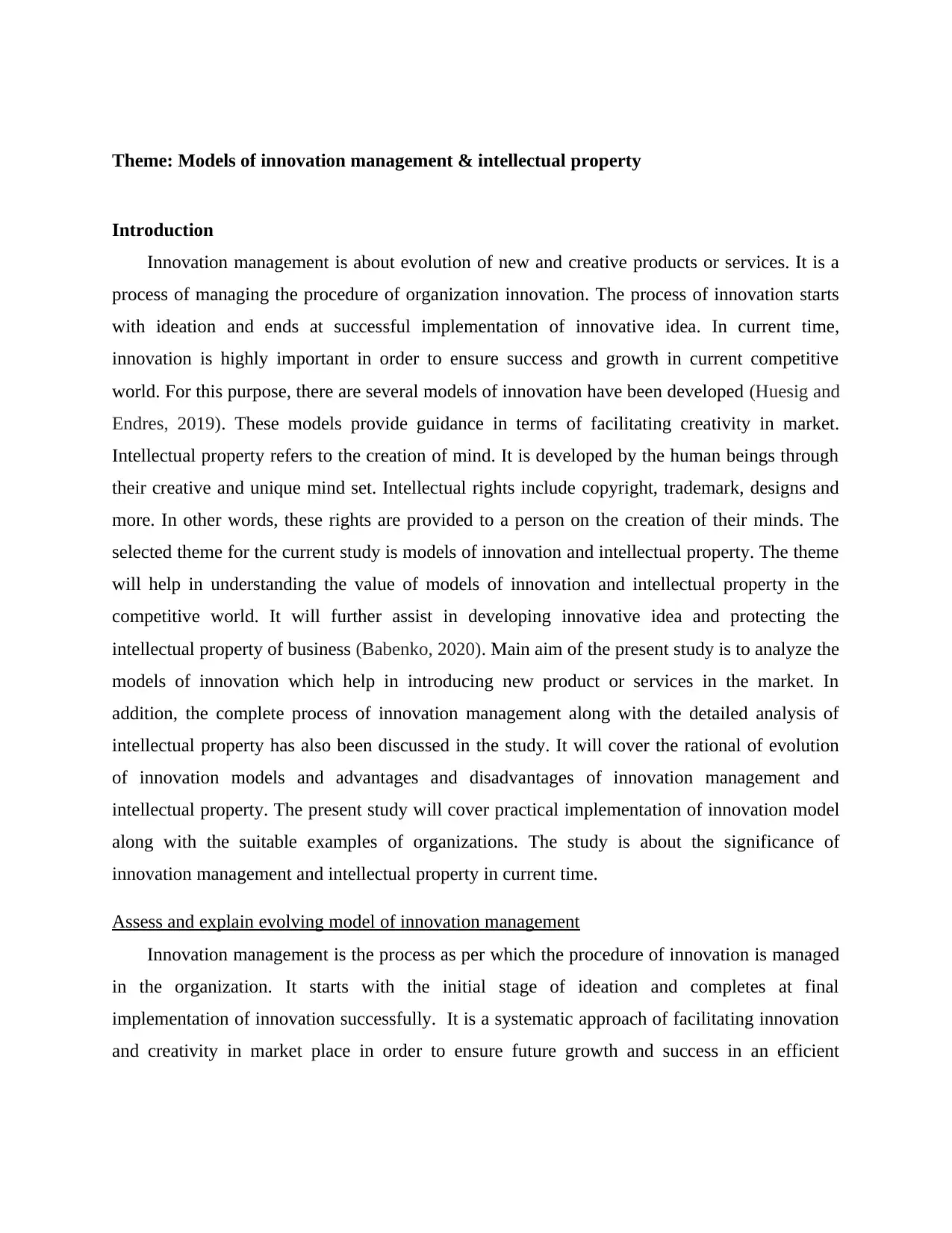
Theme: Models of innovation management & intellectual property
Introduction
Innovation management is about evolution of new and creative products or services. It is a
process of managing the procedure of organization innovation. The process of innovation starts
with ideation and ends at successful implementation of innovative idea. In current time,
innovation is highly important in order to ensure success and growth in current competitive
world. For this purpose, there are several models of innovation have been developed (Huesig and
Endres, 2019). These models provide guidance in terms of facilitating creativity in market.
Intellectual property refers to the creation of mind. It is developed by the human beings through
their creative and unique mind set. Intellectual rights include copyright, trademark, designs and
more. In other words, these rights are provided to a person on the creation of their minds. The
selected theme for the current study is models of innovation and intellectual property. The theme
will help in understanding the value of models of innovation and intellectual property in the
competitive world. It will further assist in developing innovative idea and protecting the
intellectual property of business (Babenko, 2020). Main aim of the present study is to analyze the
models of innovation which help in introducing new product or services in the market. In
addition, the complete process of innovation management along with the detailed analysis of
intellectual property has also been discussed in the study. It will cover the rational of evolution
of innovation models and advantages and disadvantages of innovation management and
intellectual property. The present study will cover practical implementation of innovation model
along with the suitable examples of organizations. The study is about the significance of
innovation management and intellectual property in current time.
Assess and explain evolving model of innovation management
Innovation management is the process as per which the procedure of innovation is managed
in the organization. It starts with the initial stage of ideation and completes at final
implementation of innovation successfully. It is a systematic approach of facilitating innovation
and creativity in market place in order to ensure future growth and success in an efficient
Introduction
Innovation management is about evolution of new and creative products or services. It is a
process of managing the procedure of organization innovation. The process of innovation starts
with ideation and ends at successful implementation of innovative idea. In current time,
innovation is highly important in order to ensure success and growth in current competitive
world. For this purpose, there are several models of innovation have been developed (Huesig and
Endres, 2019). These models provide guidance in terms of facilitating creativity in market.
Intellectual property refers to the creation of mind. It is developed by the human beings through
their creative and unique mind set. Intellectual rights include copyright, trademark, designs and
more. In other words, these rights are provided to a person on the creation of their minds. The
selected theme for the current study is models of innovation and intellectual property. The theme
will help in understanding the value of models of innovation and intellectual property in the
competitive world. It will further assist in developing innovative idea and protecting the
intellectual property of business (Babenko, 2020). Main aim of the present study is to analyze the
models of innovation which help in introducing new product or services in the market. In
addition, the complete process of innovation management along with the detailed analysis of
intellectual property has also been discussed in the study. It will cover the rational of evolution
of innovation models and advantages and disadvantages of innovation management and
intellectual property. The present study will cover practical implementation of innovation model
along with the suitable examples of organizations. The study is about the significance of
innovation management and intellectual property in current time.
Assess and explain evolving model of innovation management
Innovation management is the process as per which the procedure of innovation is managed
in the organization. It starts with the initial stage of ideation and completes at final
implementation of innovation successfully. It is a systematic approach of facilitating innovation
and creativity in market place in order to ensure future growth and success in an efficient
⊘ This is a preview!⊘
Do you want full access?
Subscribe today to unlock all pages.

Trusted by 1+ million students worldwide
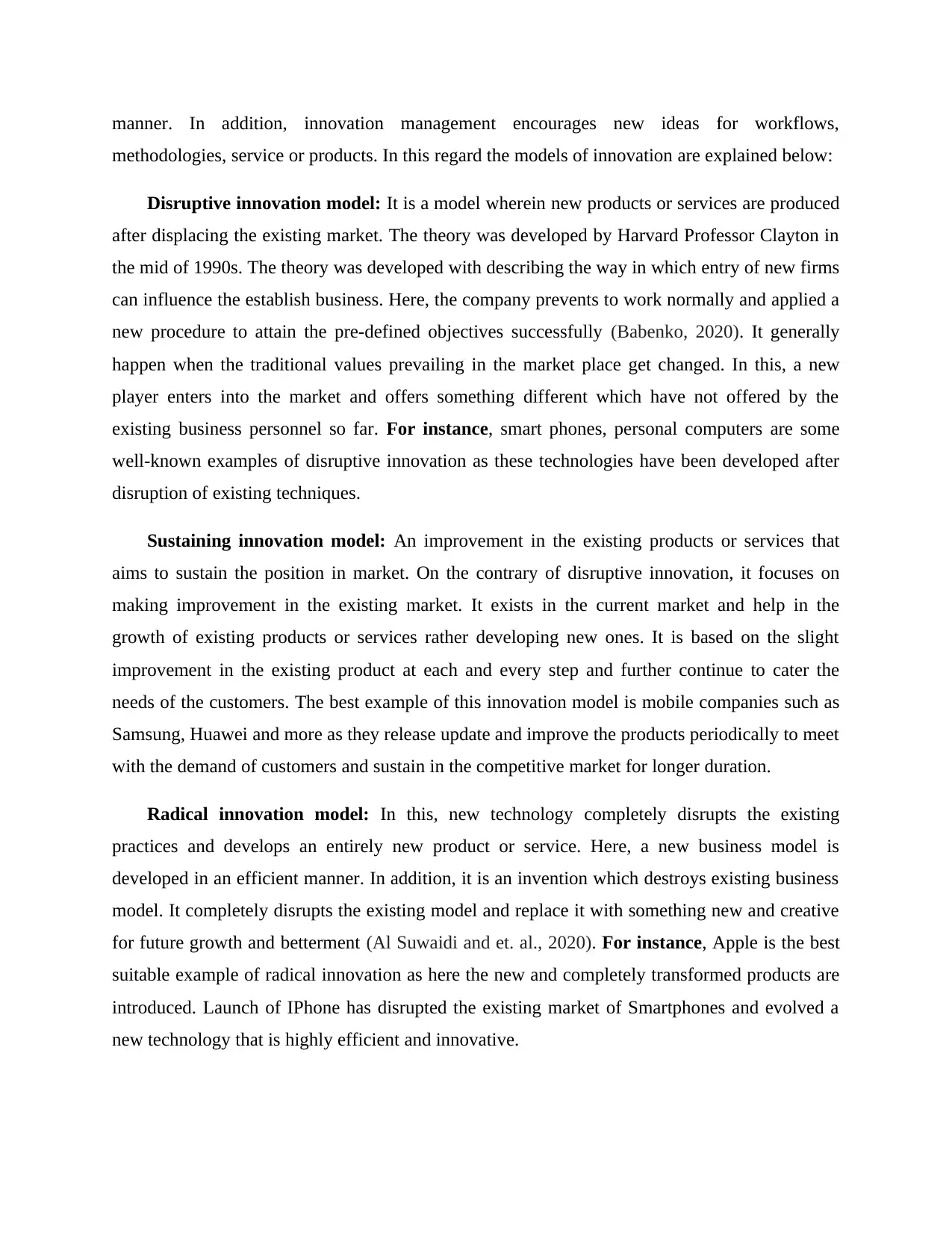
manner. In addition, innovation management encourages new ideas for workflows,
methodologies, service or products. In this regard the models of innovation are explained below:
Disruptive innovation model: It is a model wherein new products or services are produced
after displacing the existing market. The theory was developed by Harvard Professor Clayton in
the mid of 1990s. The theory was developed with describing the way in which entry of new firms
can influence the establish business. Here, the company prevents to work normally and applied a
new procedure to attain the pre-defined objectives successfully (Babenko, 2020). It generally
happen when the traditional values prevailing in the market place get changed. In this, a new
player enters into the market and offers something different which have not offered by the
existing business personnel so far. For instance, smart phones, personal computers are some
well-known examples of disruptive innovation as these technologies have been developed after
disruption of existing techniques.
Sustaining innovation model: An improvement in the existing products or services that
aims to sustain the position in market. On the contrary of disruptive innovation, it focuses on
making improvement in the existing market. It exists in the current market and help in the
growth of existing products or services rather developing new ones. It is based on the slight
improvement in the existing product at each and every step and further continue to cater the
needs of the customers. The best example of this innovation model is mobile companies such as
Samsung, Huawei and more as they release update and improve the products periodically to meet
with the demand of customers and sustain in the competitive market for longer duration.
Radical innovation model: In this, new technology completely disrupts the existing
practices and develops an entirely new product or service. Here, a new business model is
developed in an efficient manner. In addition, it is an invention which destroys existing business
model. It completely disrupts the existing model and replace it with something new and creative
for future growth and betterment (Al Suwaidi and et. al., 2020). For instance, Apple is the best
suitable example of radical innovation as here the new and completely transformed products are
introduced. Launch of IPhone has disrupted the existing market of Smartphones and evolved a
new technology that is highly efficient and innovative.
methodologies, service or products. In this regard the models of innovation are explained below:
Disruptive innovation model: It is a model wherein new products or services are produced
after displacing the existing market. The theory was developed by Harvard Professor Clayton in
the mid of 1990s. The theory was developed with describing the way in which entry of new firms
can influence the establish business. Here, the company prevents to work normally and applied a
new procedure to attain the pre-defined objectives successfully (Babenko, 2020). It generally
happen when the traditional values prevailing in the market place get changed. In this, a new
player enters into the market and offers something different which have not offered by the
existing business personnel so far. For instance, smart phones, personal computers are some
well-known examples of disruptive innovation as these technologies have been developed after
disruption of existing techniques.
Sustaining innovation model: An improvement in the existing products or services that
aims to sustain the position in market. On the contrary of disruptive innovation, it focuses on
making improvement in the existing market. It exists in the current market and help in the
growth of existing products or services rather developing new ones. It is based on the slight
improvement in the existing product at each and every step and further continue to cater the
needs of the customers. The best example of this innovation model is mobile companies such as
Samsung, Huawei and more as they release update and improve the products periodically to meet
with the demand of customers and sustain in the competitive market for longer duration.
Radical innovation model: In this, new technology completely disrupts the existing
practices and develops an entirely new product or service. Here, a new business model is
developed in an efficient manner. In addition, it is an invention which destroys existing business
model. It completely disrupts the existing model and replace it with something new and creative
for future growth and betterment (Al Suwaidi and et. al., 2020). For instance, Apple is the best
suitable example of radical innovation as here the new and completely transformed products are
introduced. Launch of IPhone has disrupted the existing market of Smartphones and evolved a
new technology that is highly efficient and innovative.
Paraphrase This Document
Need a fresh take? Get an instant paraphrase of this document with our AI Paraphraser
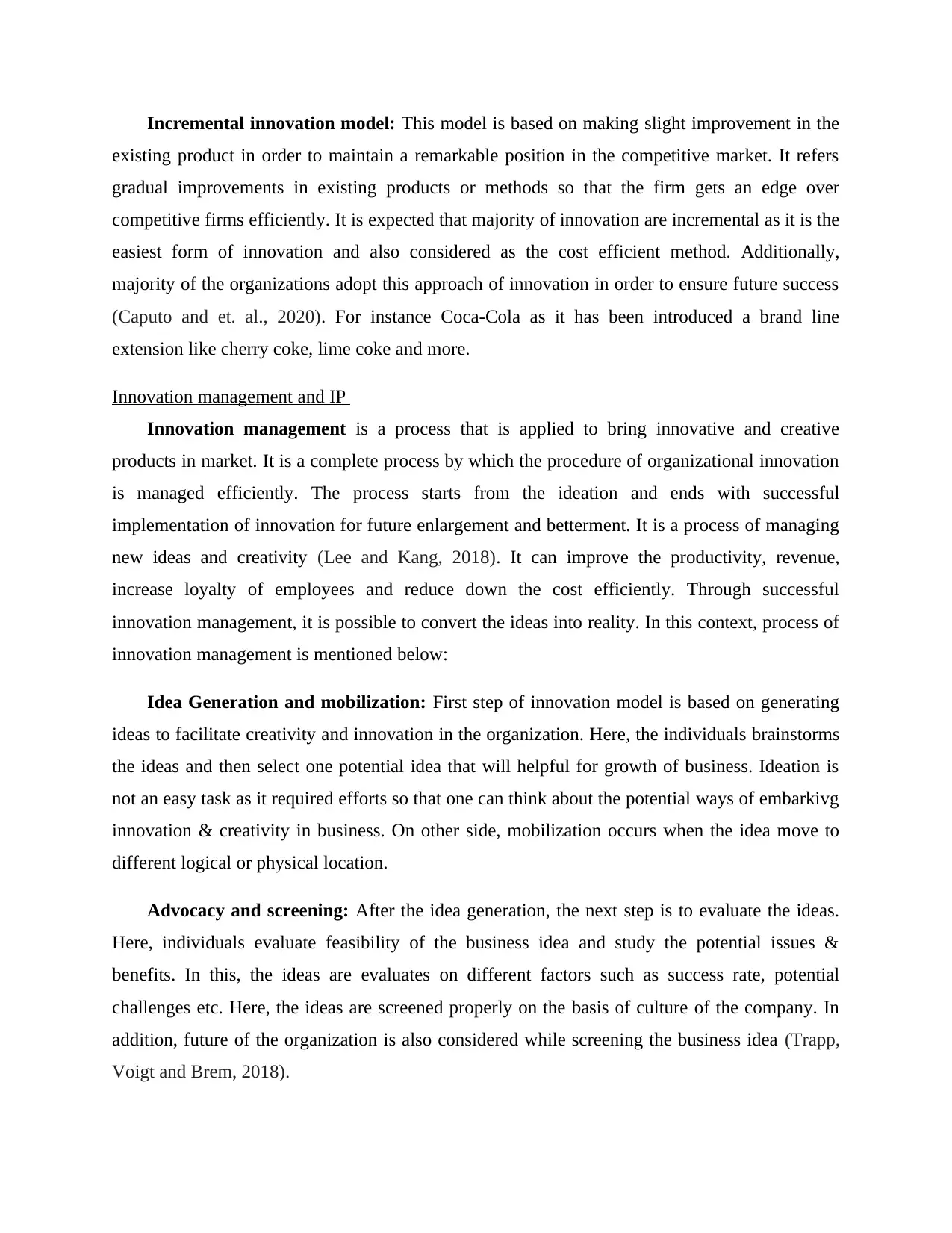
Incremental innovation model: This model is based on making slight improvement in the
existing product in order to maintain a remarkable position in the competitive market. It refers
gradual improvements in existing products or methods so that the firm gets an edge over
competitive firms efficiently. It is expected that majority of innovation are incremental as it is the
easiest form of innovation and also considered as the cost efficient method. Additionally,
majority of the organizations adopt this approach of innovation in order to ensure future success
(Caputo and et. al., 2020). For instance Coca-Cola as it has been introduced a brand line
extension like cherry coke, lime coke and more.
Innovation management and IP
Innovation management is a process that is applied to bring innovative and creative
products in market. It is a complete process by which the procedure of organizational innovation
is managed efficiently. The process starts from the ideation and ends with successful
implementation of innovation for future enlargement and betterment. It is a process of managing
new ideas and creativity (Lee and Kang, 2018). It can improve the productivity, revenue,
increase loyalty of employees and reduce down the cost efficiently. Through successful
innovation management, it is possible to convert the ideas into reality. In this context, process of
innovation management is mentioned below:
Idea Generation and mobilization: First step of innovation model is based on generating
ideas to facilitate creativity and innovation in the organization. Here, the individuals brainstorms
the ideas and then select one potential idea that will helpful for growth of business. Ideation is
not an easy task as it required efforts so that one can think about the potential ways of embarkivg
innovation & creativity in business. On other side, mobilization occurs when the idea move to
different logical or physical location.
Advocacy and screening: After the idea generation, the next step is to evaluate the ideas.
Here, individuals evaluate feasibility of the business idea and study the potential issues &
benefits. In this, the ideas are evaluates on different factors such as success rate, potential
challenges etc. Here, the ideas are screened properly on the basis of culture of the company. In
addition, future of the organization is also considered while screening the business idea (Trapp,
Voigt and Brem, 2018).
existing product in order to maintain a remarkable position in the competitive market. It refers
gradual improvements in existing products or methods so that the firm gets an edge over
competitive firms efficiently. It is expected that majority of innovation are incremental as it is the
easiest form of innovation and also considered as the cost efficient method. Additionally,
majority of the organizations adopt this approach of innovation in order to ensure future success
(Caputo and et. al., 2020). For instance Coca-Cola as it has been introduced a brand line
extension like cherry coke, lime coke and more.
Innovation management and IP
Innovation management is a process that is applied to bring innovative and creative
products in market. It is a complete process by which the procedure of organizational innovation
is managed efficiently. The process starts from the ideation and ends with successful
implementation of innovation for future enlargement and betterment. It is a process of managing
new ideas and creativity (Lee and Kang, 2018). It can improve the productivity, revenue,
increase loyalty of employees and reduce down the cost efficiently. Through successful
innovation management, it is possible to convert the ideas into reality. In this context, process of
innovation management is mentioned below:
Idea Generation and mobilization: First step of innovation model is based on generating
ideas to facilitate creativity and innovation in the organization. Here, the individuals brainstorms
the ideas and then select one potential idea that will helpful for growth of business. Ideation is
not an easy task as it required efforts so that one can think about the potential ways of embarkivg
innovation & creativity in business. On other side, mobilization occurs when the idea move to
different logical or physical location.
Advocacy and screening: After the idea generation, the next step is to evaluate the ideas.
Here, individuals evaluate feasibility of the business idea and study the potential issues &
benefits. In this, the ideas are evaluates on different factors such as success rate, potential
challenges etc. Here, the ideas are screened properly on the basis of culture of the company. In
addition, future of the organization is also considered while screening the business idea (Trapp,
Voigt and Brem, 2018).
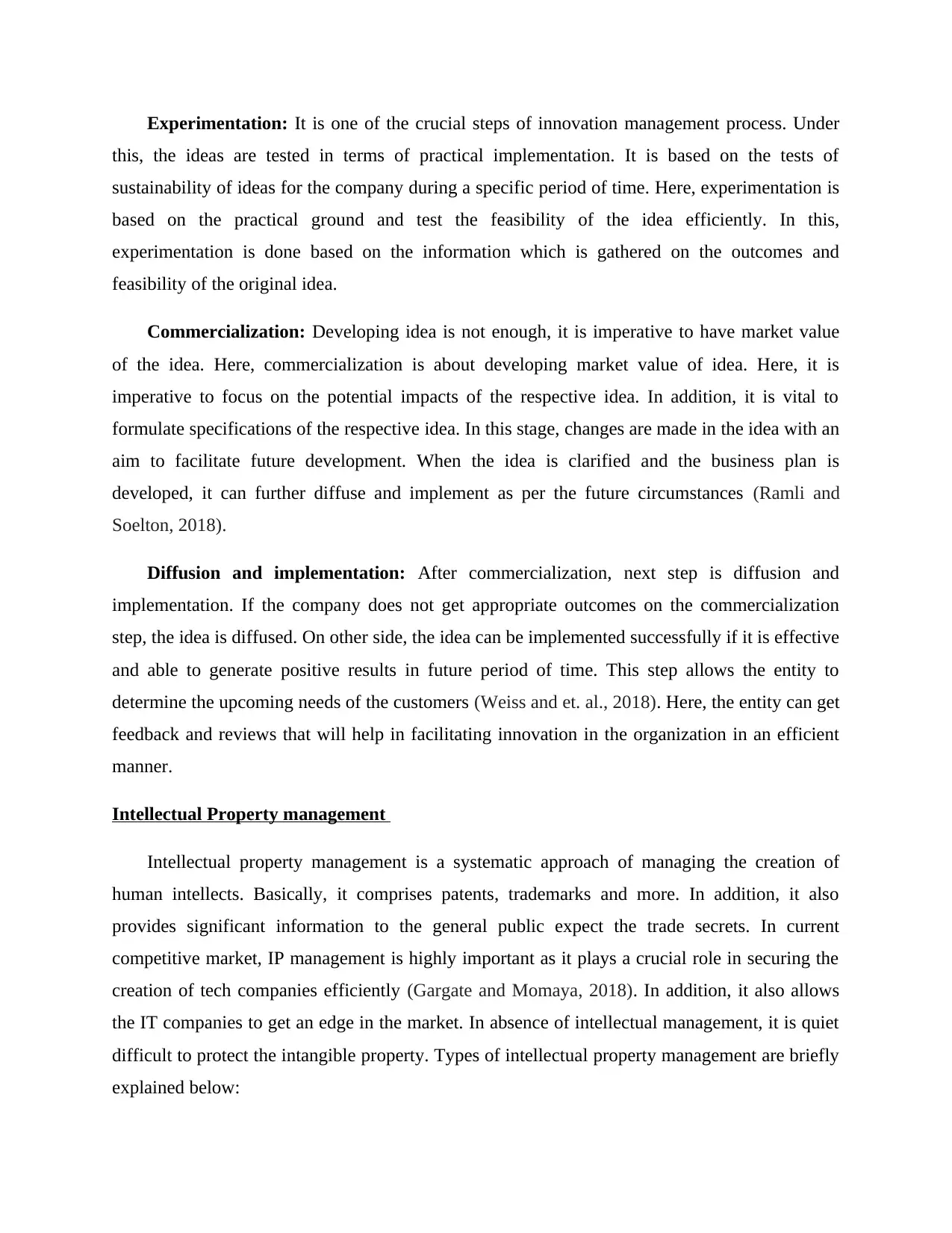
Experimentation: It is one of the crucial steps of innovation management process. Under
this, the ideas are tested in terms of practical implementation. It is based on the tests of
sustainability of ideas for the company during a specific period of time. Here, experimentation is
based on the practical ground and test the feasibility of the idea efficiently. In this,
experimentation is done based on the information which is gathered on the outcomes and
feasibility of the original idea.
Commercialization: Developing idea is not enough, it is imperative to have market value
of the idea. Here, commercialization is about developing market value of idea. Here, it is
imperative to focus on the potential impacts of the respective idea. In addition, it is vital to
formulate specifications of the respective idea. In this stage, changes are made in the idea with an
aim to facilitate future development. When the idea is clarified and the business plan is
developed, it can further diffuse and implement as per the future circumstances (Ramli and
Soelton, 2018).
Diffusion and implementation: After commercialization, next step is diffusion and
implementation. If the company does not get appropriate outcomes on the commercialization
step, the idea is diffused. On other side, the idea can be implemented successfully if it is effective
and able to generate positive results in future period of time. This step allows the entity to
determine the upcoming needs of the customers (Weiss and et. al., 2018). Here, the entity can get
feedback and reviews that will help in facilitating innovation in the organization in an efficient
manner.
Intellectual Property management
Intellectual property management is a systematic approach of managing the creation of
human intellects. Basically, it comprises patents, trademarks and more. In addition, it also
provides significant information to the general public expect the trade secrets. In current
competitive market, IP management is highly important as it plays a crucial role in securing the
creation of tech companies efficiently (Gargate and Momaya, 2018). In addition, it also allows
the IT companies to get an edge in the market. In absence of intellectual management, it is quiet
difficult to protect the intangible property. Types of intellectual property management are briefly
explained below:
this, the ideas are tested in terms of practical implementation. It is based on the tests of
sustainability of ideas for the company during a specific period of time. Here, experimentation is
based on the practical ground and test the feasibility of the idea efficiently. In this,
experimentation is done based on the information which is gathered on the outcomes and
feasibility of the original idea.
Commercialization: Developing idea is not enough, it is imperative to have market value
of the idea. Here, commercialization is about developing market value of idea. Here, it is
imperative to focus on the potential impacts of the respective idea. In addition, it is vital to
formulate specifications of the respective idea. In this stage, changes are made in the idea with an
aim to facilitate future development. When the idea is clarified and the business plan is
developed, it can further diffuse and implement as per the future circumstances (Ramli and
Soelton, 2018).
Diffusion and implementation: After commercialization, next step is diffusion and
implementation. If the company does not get appropriate outcomes on the commercialization
step, the idea is diffused. On other side, the idea can be implemented successfully if it is effective
and able to generate positive results in future period of time. This step allows the entity to
determine the upcoming needs of the customers (Weiss and et. al., 2018). Here, the entity can get
feedback and reviews that will help in facilitating innovation in the organization in an efficient
manner.
Intellectual Property management
Intellectual property management is a systematic approach of managing the creation of
human intellects. Basically, it comprises patents, trademarks and more. In addition, it also
provides significant information to the general public expect the trade secrets. In current
competitive market, IP management is highly important as it plays a crucial role in securing the
creation of tech companies efficiently (Gargate and Momaya, 2018). In addition, it also allows
the IT companies to get an edge in the market. In absence of intellectual management, it is quiet
difficult to protect the intangible property. Types of intellectual property management are briefly
explained below:
⊘ This is a preview!⊘
Do you want full access?
Subscribe today to unlock all pages.

Trusted by 1+ million students worldwide
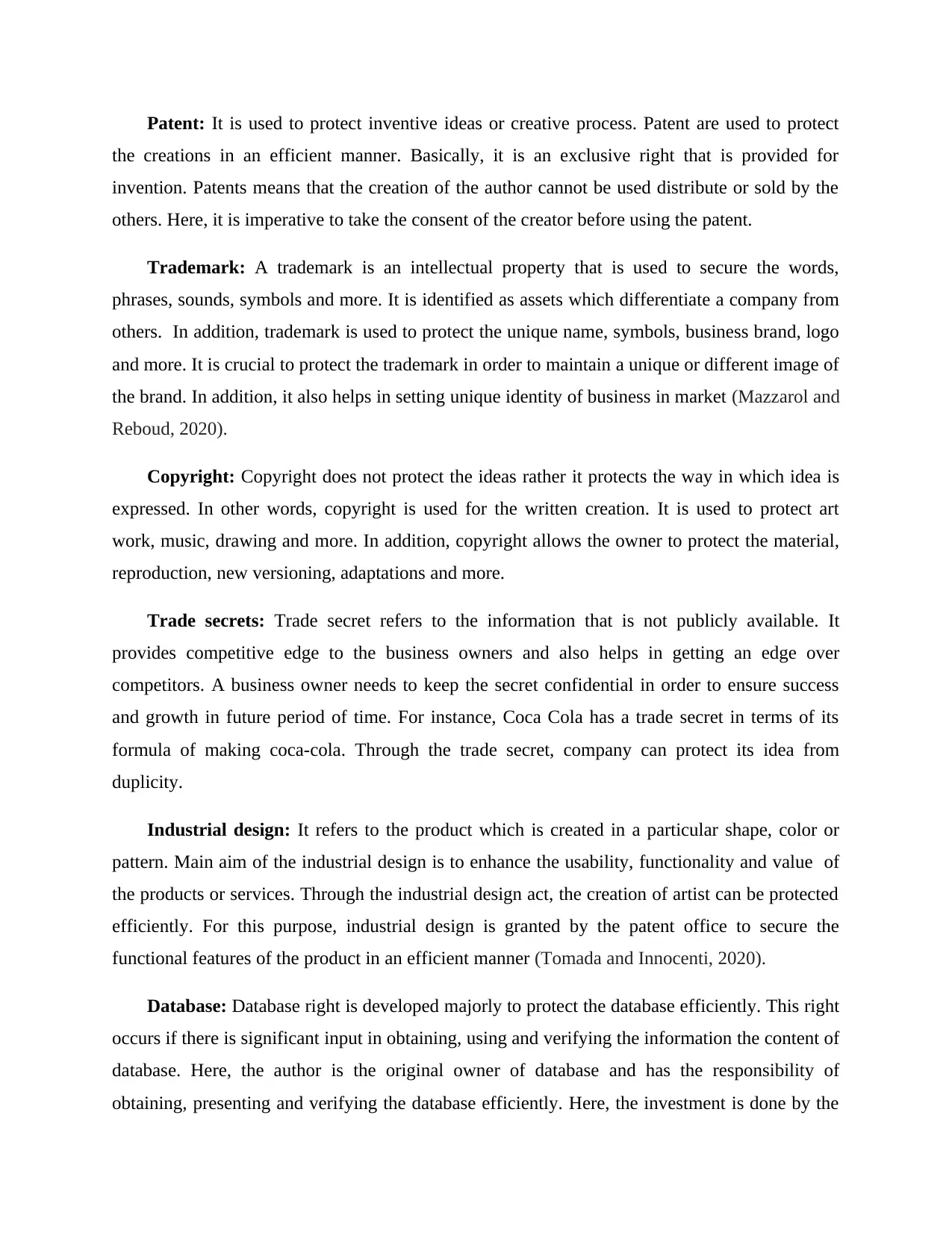
Patent: It is used to protect inventive ideas or creative process. Patent are used to protect
the creations in an efficient manner. Basically, it is an exclusive right that is provided for
invention. Patents means that the creation of the author cannot be used distribute or sold by the
others. Here, it is imperative to take the consent of the creator before using the patent.
Trademark: A trademark is an intellectual property that is used to secure the words,
phrases, sounds, symbols and more. It is identified as assets which differentiate a company from
others. In addition, trademark is used to protect the unique name, symbols, business brand, logo
and more. It is crucial to protect the trademark in order to maintain a unique or different image of
the brand. In addition, it also helps in setting unique identity of business in market (Mazzarol and
Reboud, 2020).
Copyright: Copyright does not protect the ideas rather it protects the way in which idea is
expressed. In other words, copyright is used for the written creation. It is used to protect art
work, music, drawing and more. In addition, copyright allows the owner to protect the material,
reproduction, new versioning, adaptations and more.
Trade secrets: Trade secret refers to the information that is not publicly available. It
provides competitive edge to the business owners and also helps in getting an edge over
competitors. A business owner needs to keep the secret confidential in order to ensure success
and growth in future period of time. For instance, Coca Cola has a trade secret in terms of its
formula of making coca-cola. Through the trade secret, company can protect its idea from
duplicity.
Industrial design: It refers to the product which is created in a particular shape, color or
pattern. Main aim of the industrial design is to enhance the usability, functionality and value of
the products or services. Through the industrial design act, the creation of artist can be protected
efficiently. For this purpose, industrial design is granted by the patent office to secure the
functional features of the product in an efficient manner (Tomada and Innocenti, 2020).
Database: Database right is developed majorly to protect the database efficiently. This right
occurs if there is significant input in obtaining, using and verifying the information the content of
database. Here, the author is the original owner of database and has the responsibility of
obtaining, presenting and verifying the database efficiently. Here, the investment is done by the
the creations in an efficient manner. Basically, it is an exclusive right that is provided for
invention. Patents means that the creation of the author cannot be used distribute or sold by the
others. Here, it is imperative to take the consent of the creator before using the patent.
Trademark: A trademark is an intellectual property that is used to secure the words,
phrases, sounds, symbols and more. It is identified as assets which differentiate a company from
others. In addition, trademark is used to protect the unique name, symbols, business brand, logo
and more. It is crucial to protect the trademark in order to maintain a unique or different image of
the brand. In addition, it also helps in setting unique identity of business in market (Mazzarol and
Reboud, 2020).
Copyright: Copyright does not protect the ideas rather it protects the way in which idea is
expressed. In other words, copyright is used for the written creation. It is used to protect art
work, music, drawing and more. In addition, copyright allows the owner to protect the material,
reproduction, new versioning, adaptations and more.
Trade secrets: Trade secret refers to the information that is not publicly available. It
provides competitive edge to the business owners and also helps in getting an edge over
competitors. A business owner needs to keep the secret confidential in order to ensure success
and growth in future period of time. For instance, Coca Cola has a trade secret in terms of its
formula of making coca-cola. Through the trade secret, company can protect its idea from
duplicity.
Industrial design: It refers to the product which is created in a particular shape, color or
pattern. Main aim of the industrial design is to enhance the usability, functionality and value of
the products or services. Through the industrial design act, the creation of artist can be protected
efficiently. For this purpose, industrial design is granted by the patent office to secure the
functional features of the product in an efficient manner (Tomada and Innocenti, 2020).
Database: Database right is developed majorly to protect the database efficiently. This right
occurs if there is significant input in obtaining, using and verifying the information the content of
database. Here, the author is the original owner of database and has the responsibility of
obtaining, presenting and verifying the database efficiently. Here, the investment is done by the
Paraphrase This Document
Need a fresh take? Get an instant paraphrase of this document with our AI Paraphraser
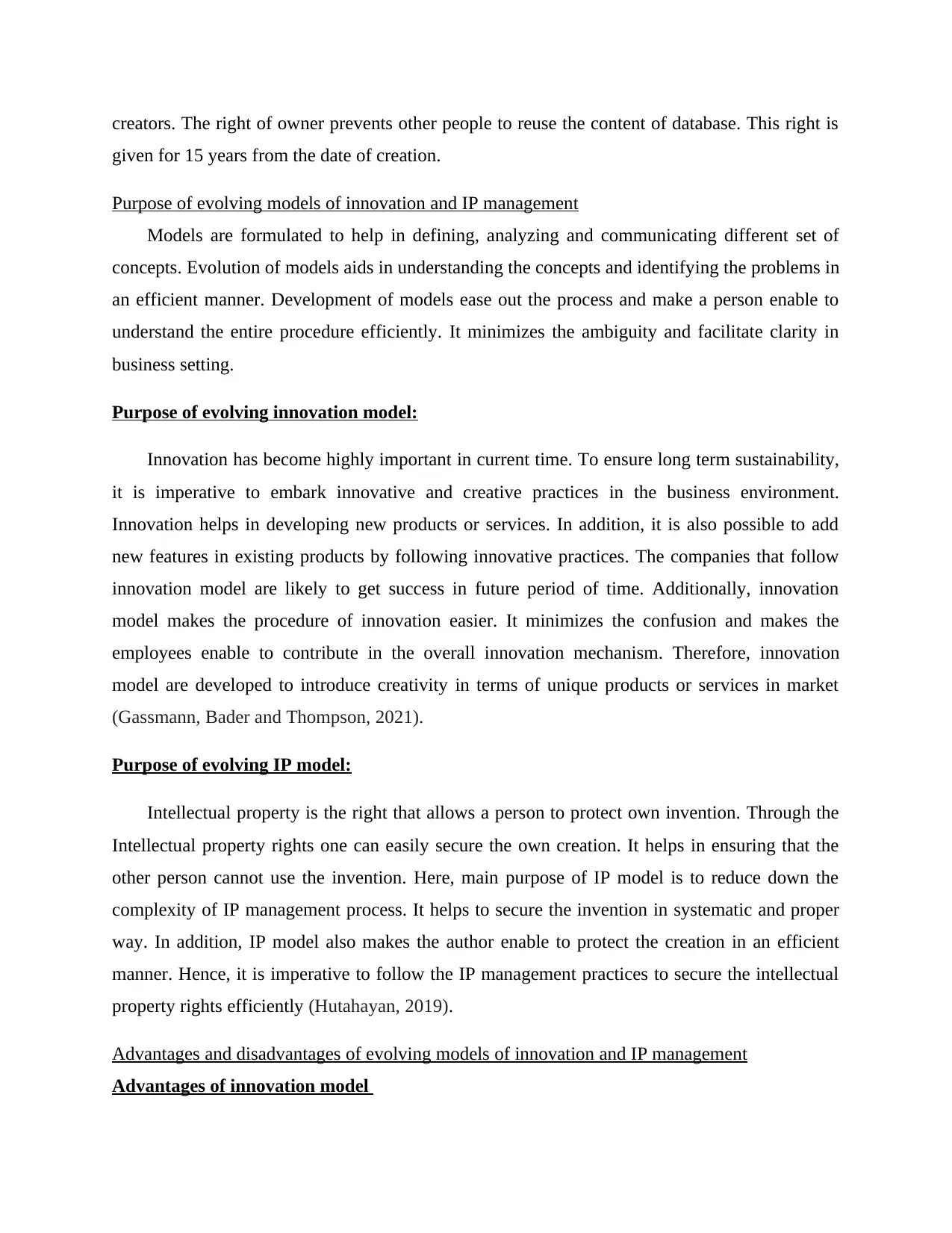
creators. The right of owner prevents other people to reuse the content of database. This right is
given for 15 years from the date of creation.
Purpose of evolving models of innovation and IP management
Models are formulated to help in defining, analyzing and communicating different set of
concepts. Evolution of models aids in understanding the concepts and identifying the problems in
an efficient manner. Development of models ease out the process and make a person enable to
understand the entire procedure efficiently. It minimizes the ambiguity and facilitate clarity in
business setting.
Purpose of evolving innovation model:
Innovation has become highly important in current time. To ensure long term sustainability,
it is imperative to embark innovative and creative practices in the business environment.
Innovation helps in developing new products or services. In addition, it is also possible to add
new features in existing products by following innovative practices. The companies that follow
innovation model are likely to get success in future period of time. Additionally, innovation
model makes the procedure of innovation easier. It minimizes the confusion and makes the
employees enable to contribute in the overall innovation mechanism. Therefore, innovation
model are developed to introduce creativity in terms of unique products or services in market
(Gassmann, Bader and Thompson, 2021).
Purpose of evolving IP model:
Intellectual property is the right that allows a person to protect own invention. Through the
Intellectual property rights one can easily secure the own creation. It helps in ensuring that the
other person cannot use the invention. Here, main purpose of IP model is to reduce down the
complexity of IP management process. It helps to secure the invention in systematic and proper
way. In addition, IP model also makes the author enable to protect the creation in an efficient
manner. Hence, it is imperative to follow the IP management practices to secure the intellectual
property rights efficiently (Hutahayan, 2019).
Advantages and disadvantages of evolving models of innovation and IP management
Advantages of innovation model
given for 15 years from the date of creation.
Purpose of evolving models of innovation and IP management
Models are formulated to help in defining, analyzing and communicating different set of
concepts. Evolution of models aids in understanding the concepts and identifying the problems in
an efficient manner. Development of models ease out the process and make a person enable to
understand the entire procedure efficiently. It minimizes the ambiguity and facilitate clarity in
business setting.
Purpose of evolving innovation model:
Innovation has become highly important in current time. To ensure long term sustainability,
it is imperative to embark innovative and creative practices in the business environment.
Innovation helps in developing new products or services. In addition, it is also possible to add
new features in existing products by following innovative practices. The companies that follow
innovation model are likely to get success in future period of time. Additionally, innovation
model makes the procedure of innovation easier. It minimizes the confusion and makes the
employees enable to contribute in the overall innovation mechanism. Therefore, innovation
model are developed to introduce creativity in terms of unique products or services in market
(Gassmann, Bader and Thompson, 2021).
Purpose of evolving IP model:
Intellectual property is the right that allows a person to protect own invention. Through the
Intellectual property rights one can easily secure the own creation. It helps in ensuring that the
other person cannot use the invention. Here, main purpose of IP model is to reduce down the
complexity of IP management process. It helps to secure the invention in systematic and proper
way. In addition, IP model also makes the author enable to protect the creation in an efficient
manner. Hence, it is imperative to follow the IP management practices to secure the intellectual
property rights efficiently (Hutahayan, 2019).
Advantages and disadvantages of evolving models of innovation and IP management
Advantages of innovation model

Increase productivity: Innovation model enhanced the efficiently of overall production
process. It helps in making efficient use of available resourced, equipments and tools by adopting
creative and innovative approaches. By this way, evolution of innovation model has direct link
with productivity that is a crucial aspect of organizational success.
Increase competitiveness: Innovation is helpful in creating difference by producing unique
products or services. It facilities creativity in the business setting and further allows a company
in staying in the competitive market place for longer duration (Bettig, 2018).
Enhance market value: Intellectual property plays a crucial role in protecting the rights
related to invention. In addition, it helps in securing and protecting the creation of authors. Here
the authors can use the right to enhance the business. They can easily attract high number of
buyers through innovative and unique idea. This practice further enhances the market share
profoundly (Toma, Secundo and Passiante, 2018).
Generate Opportunities: Intellectual property rights can use by the business owner to
expand the business. Here, they can sell the rights to other people to earn more profit. Hence, the
IP management model generates opportunities of business enlargement and enhancement.
Disadvantages of evolving innovation and IP management model
Lack of Collaboration: For successful implementation of innovation model, it is important
to maintain proper collaboration among employees. Here, collaboration is crucial to implement
innovation in an efficient manner. In this situation, lack of collaboration will affect the overall
innovation process of the organization (Gupta, 2018).
Lack of Diversity: In current time, people belong from different culture work together in an
organization. Diversify workforce plays a crucial role in organizational success. However, lack
of diversity will put major impact on the success of innovation management model.
Incurred Cost: To evolve the IP model, a complete procedure is followed that required
huge cost. It enhances the overall expenses and make the entire procedure costly.
process. It helps in making efficient use of available resourced, equipments and tools by adopting
creative and innovative approaches. By this way, evolution of innovation model has direct link
with productivity that is a crucial aspect of organizational success.
Increase competitiveness: Innovation is helpful in creating difference by producing unique
products or services. It facilities creativity in the business setting and further allows a company
in staying in the competitive market place for longer duration (Bettig, 2018).
Enhance market value: Intellectual property plays a crucial role in protecting the rights
related to invention. In addition, it helps in securing and protecting the creation of authors. Here
the authors can use the right to enhance the business. They can easily attract high number of
buyers through innovative and unique idea. This practice further enhances the market share
profoundly (Toma, Secundo and Passiante, 2018).
Generate Opportunities: Intellectual property rights can use by the business owner to
expand the business. Here, they can sell the rights to other people to earn more profit. Hence, the
IP management model generates opportunities of business enlargement and enhancement.
Disadvantages of evolving innovation and IP management model
Lack of Collaboration: For successful implementation of innovation model, it is important
to maintain proper collaboration among employees. Here, collaboration is crucial to implement
innovation in an efficient manner. In this situation, lack of collaboration will affect the overall
innovation process of the organization (Gupta, 2018).
Lack of Diversity: In current time, people belong from different culture work together in an
organization. Diversify workforce plays a crucial role in organizational success. However, lack
of diversity will put major impact on the success of innovation management model.
Incurred Cost: To evolve the IP model, a complete procedure is followed that required
huge cost. It enhances the overall expenses and make the entire procedure costly.
⊘ This is a preview!⊘
Do you want full access?
Subscribe today to unlock all pages.

Trusted by 1+ million students worldwide
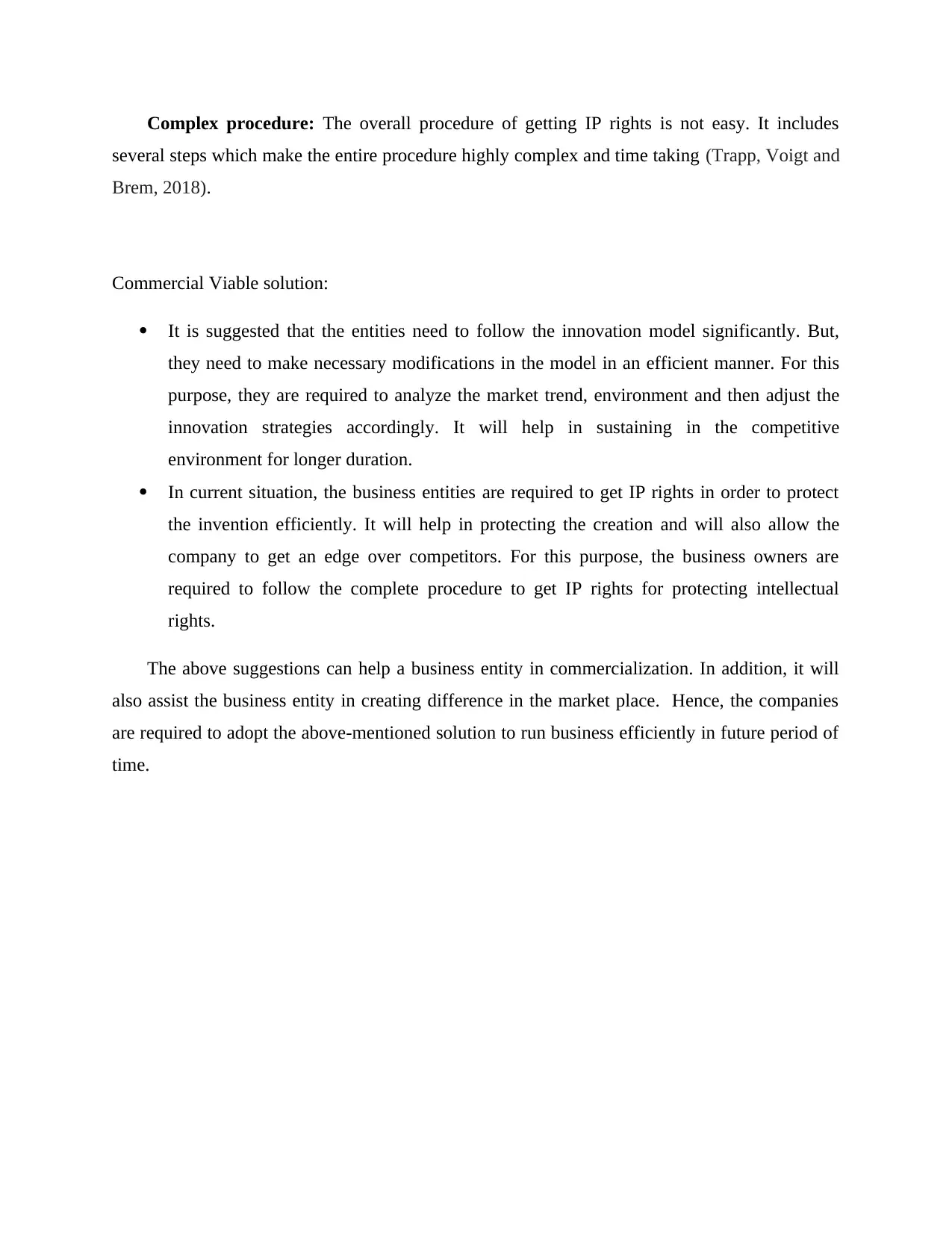
Complex procedure: The overall procedure of getting IP rights is not easy. It includes
several steps which make the entire procedure highly complex and time taking (Trapp, Voigt and
Brem, 2018).
Commercial Viable solution:
It is suggested that the entities need to follow the innovation model significantly. But,
they need to make necessary modifications in the model in an efficient manner. For this
purpose, they are required to analyze the market trend, environment and then adjust the
innovation strategies accordingly. It will help in sustaining in the competitive
environment for longer duration.
In current situation, the business entities are required to get IP rights in order to protect
the invention efficiently. It will help in protecting the creation and will also allow the
company to get an edge over competitors. For this purpose, the business owners are
required to follow the complete procedure to get IP rights for protecting intellectual
rights.
The above suggestions can help a business entity in commercialization. In addition, it will
also assist the business entity in creating difference in the market place. Hence, the companies
are required to adopt the above-mentioned solution to run business efficiently in future period of
time.
several steps which make the entire procedure highly complex and time taking (Trapp, Voigt and
Brem, 2018).
Commercial Viable solution:
It is suggested that the entities need to follow the innovation model significantly. But,
they need to make necessary modifications in the model in an efficient manner. For this
purpose, they are required to analyze the market trend, environment and then adjust the
innovation strategies accordingly. It will help in sustaining in the competitive
environment for longer duration.
In current situation, the business entities are required to get IP rights in order to protect
the invention efficiently. It will help in protecting the creation and will also allow the
company to get an edge over competitors. For this purpose, the business owners are
required to follow the complete procedure to get IP rights for protecting intellectual
rights.
The above suggestions can help a business entity in commercialization. In addition, it will
also assist the business entity in creating difference in the market place. Hence, the companies
are required to adopt the above-mentioned solution to run business efficiently in future period of
time.
Paraphrase This Document
Need a fresh take? Get an instant paraphrase of this document with our AI Paraphraser

Conclusion
Through above-mentioned information, it is analyzed that innovation is process of
generating new, creative and unique ideas. It helps in developing unique products or services
which are not present in the market so far. It is monitored that innovation management is a
process of embarking innovation & creativity in business efficiently whereas IP management is
used to protect the creation of authors. It is concluded that there are several model have been
evolved for innovation and IP management. Main purpose of these models is to minimize the
complexity and facilitate clarity in the organization. There is discussion regarding advantages
and disadvantages of innovation management and IP management model. It is suggested that the
companies need to facilitate innovation and use Intellectual property right to protect the creation
efficiently.
Through above-mentioned information, it is analyzed that innovation is process of
generating new, creative and unique ideas. It helps in developing unique products or services
which are not present in the market so far. It is monitored that innovation management is a
process of embarking innovation & creativity in business efficiently whereas IP management is
used to protect the creation of authors. It is concluded that there are several model have been
evolved for innovation and IP management. Main purpose of these models is to minimize the
complexity and facilitate clarity in the organization. There is discussion regarding advantages
and disadvantages of innovation management and IP management model. It is suggested that the
companies need to facilitate innovation and use Intellectual property right to protect the creation
efficiently.
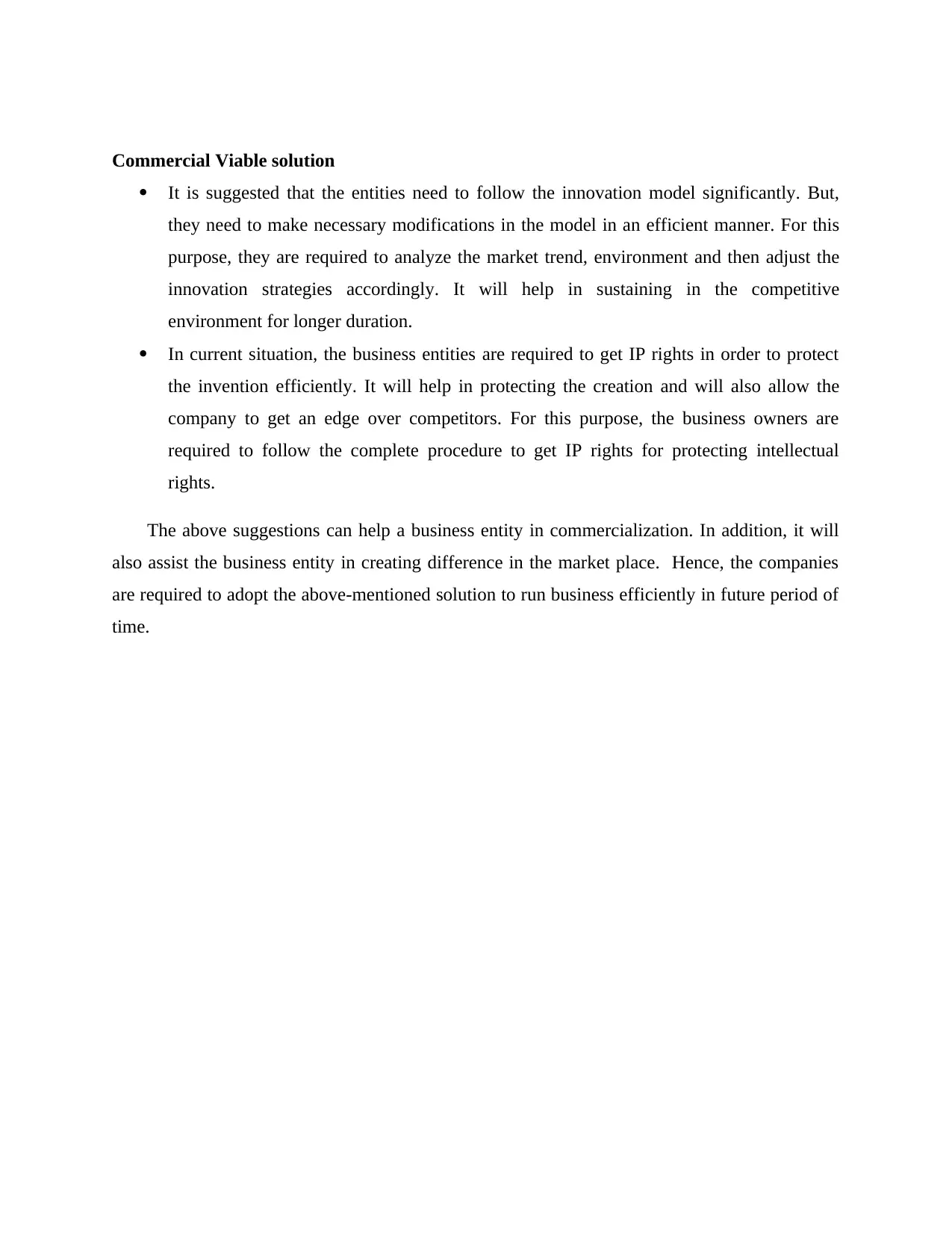
Commercial Viable solution
It is suggested that the entities need to follow the innovation model significantly. But,
they need to make necessary modifications in the model in an efficient manner. For this
purpose, they are required to analyze the market trend, environment and then adjust the
innovation strategies accordingly. It will help in sustaining in the competitive
environment for longer duration.
In current situation, the business entities are required to get IP rights in order to protect
the invention efficiently. It will help in protecting the creation and will also allow the
company to get an edge over competitors. For this purpose, the business owners are
required to follow the complete procedure to get IP rights for protecting intellectual
rights.
The above suggestions can help a business entity in commercialization. In addition, it will
also assist the business entity in creating difference in the market place. Hence, the companies
are required to adopt the above-mentioned solution to run business efficiently in future period of
time.
It is suggested that the entities need to follow the innovation model significantly. But,
they need to make necessary modifications in the model in an efficient manner. For this
purpose, they are required to analyze the market trend, environment and then adjust the
innovation strategies accordingly. It will help in sustaining in the competitive
environment for longer duration.
In current situation, the business entities are required to get IP rights in order to protect
the invention efficiently. It will help in protecting the creation and will also allow the
company to get an edge over competitors. For this purpose, the business owners are
required to follow the complete procedure to get IP rights for protecting intellectual
rights.
The above suggestions can help a business entity in commercialization. In addition, it will
also assist the business entity in creating difference in the market place. Hence, the companies
are required to adopt the above-mentioned solution to run business efficiently in future period of
time.
⊘ This is a preview!⊘
Do you want full access?
Subscribe today to unlock all pages.

Trusted by 1+ million students worldwide
1 out of 15
Related Documents
Your All-in-One AI-Powered Toolkit for Academic Success.
+13062052269
info@desklib.com
Available 24*7 on WhatsApp / Email
![[object Object]](/_next/static/media/star-bottom.7253800d.svg)
Unlock your academic potential
Copyright © 2020–2025 A2Z Services. All Rights Reserved. Developed and managed by ZUCOL.




